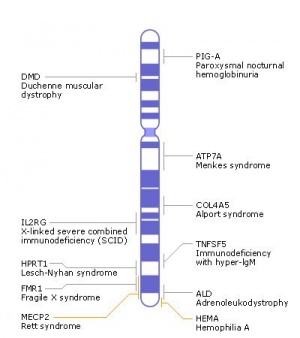X Chromosome: Difference between revisions
From Embryology
No edit summary |
|||
| Line 10: | Line 10: | ||
* Genes encode house-keeping and specialized functions. | * Genes encode house-keeping and specialized functions. | ||
* Conserved in gene content between species. | * Conserved in gene content between species. | ||
* In females, one of the X-chromosomes is inactivated in each and every cell | * In females, one of the X-chromosomes is inactivated in each and every cell (known since 1961). | ||
** This inactivation occurs during embryogenesis. | ** This inactivation occurs during embryogenesis. | ||
** X Inactivation appears to be random in somatic cells. (mosaic pattern) | ** X Inactivation appears to be random in somatic cells. (mosaic pattern) | ||
** The process starts at the "X inactivation centre" and spreads along the chromosome. | ** The process starts at the "X inactivation centre" and spreads along the chromosome. | ||
Revision as of 08:24, 14 March 2010
Introduction
This section of notes introduces the X chromosome and its role in development. There is a separate page discussing X chromosome inactivation that occurs in female development to provide the correct gene dosage.
X Chromosome Overview
- 1400+ genes
- 150 million base pairs
- Contains about 5% of the haploid genome.
- Genes encode house-keeping and specialized functions.
- Conserved in gene content between species.
- In females, one of the X-chromosomes is inactivated in each and every cell (known since 1961).
- This inactivation occurs during embryogenesis.
- X Inactivation appears to be random in somatic cells. (mosaic pattern)
- The process starts at the "X inactivation centre" and spreads along the chromosome.
